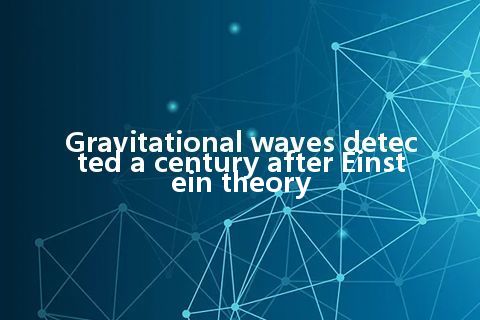“This is truly scientific moonshot. We did it. We landed on the moon,” exclaimed David Reitz, executive director of the LIGO Laboratory at Caltech, at the conference in the National Press Club.

According to the National Science Foundation (NSF) experts, gravitational waves carry information about their dramatic origins and about the nature of gravity that cannot be obtained from elsewhere. Physicists have concluded that the detected gravitational waves were produced during the final fraction of a second of the merger of two black holes to produce a single, more massive spinning black hole. This collision of two black holes had been predicted but never observed.
The gravitational waves were detected on Sept 14, 2015 at 5:51 am EDT by both of the twin Laser Interferometer Gravitational-wave Observatory (LIGO) detectors, located in Livingston, Louisiana, and Hanford, Washington.
based on the observed signals, LIGO scientists estimate that the black holes for this event were about 29 and 36 times the mass of the sun, and the event took place 1.3 billion years ago. about three times the mass of the sun was converted into gravitational waves in a fraction of a second -- with a peak power output about 50 times that of the whole visible universe. By looking at the time of arrival of the signals -- the detector in Livingston recorded the event 7 milliseconds before the detector in Hanford -- scientists can say that the source was located in the Southern Hemisphere, according to a press release from NSF, which funded the research.
According to general relativity, a pair of black holes orbiting around each other lose energy through the emission of gravitational waves, causing them to gradually approach each other over billions of years, and then much more quickly in the final minutes. During the final fraction of a second, the two black holes collide at nearly half the speed of light and form a single more massive black hole, converting a portion of the combined black holes' mass to energy, according to Einstein's formula E=mc2. This energy is emitted as a final strong burst of gravitational waves. These are the gravitational waves that LIGO observed.
The existence of gravitational waves was first demonstrated in the 1970s and 1980s by Joseph Taylor, Jr., and colleagues. In 1974, Taylor and Russell Hulse discovered a binary system composed of a pulsar in orbit around a neutron star. Taylor and Joel M. Weisberg in 1982 found that the orbit of the pulsar was slowly shrinking over time because of the release of energy in the form of gravitational waves. For discovering the pulsar and showing that it would make possible this particular gravitational wave measurement, Hulse and Taylor were awarded the 1993 Nobel Prize in Physics.
The new LIGO discovery is the first observation of gravitational waves themselves, made by measuring the tiny disturbances the waves make to space and time as they pass through the earth.
“Our observation of gravitational waves accomplishes an ambitious goal set out over five decades ago to directly detect this elusive phenomenon and better understand the universe, and, fittingly, fulfills Einstein's legacy on the 100th anniversary of his general theory of relativity,” Reitze said.
LIGO research is carried out by the LIGO Scientific Collaboration (LSC), a group of more than 1,000 scientists from universities around the United States and in 14 other countries. More than 90 universities and research institutes in the LSC develop detector technology and analyze data; approximately 250 students are strong contributing members of the collaboration.
“This detection is the beginning of a new era: The field of gravitational wave astronomy is now a reality,” says Gabriela Gonzalez, LSC spokesperson and professor of physics and astronomy at Louisiana State University.
LIGO was originally proposed as a means of detecting gravitational waves in the 1980s by Rainer Weiss from MIT; Kip Thorne and Ronald Drever, both from Caltech.
“The description of this observation is beautifully described in the Einstein theory of general relativity formulated 100 years ago and comprises the first test of the theory in strong gravitation. It would have been wonderful to watch Einstein's face had we been able to tell him,” Weiss said.
“With this discovery, we humans are embarking on a marvelous new quest: the quest to explore the warped side of the universe -- objects and phenomena that are made from warped spacetime. Colliding black holes and gravitational waves are our first beautiful examples,” said Thorne.